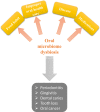A comprehensive review of the application of probiotics and postbiotics in oral health
- PMID: 36968114
- PMCID: PMC10031100
- DOI: 10.3389/fcimb.2023.1120995
A comprehensive review of the application of probiotics and postbiotics in oral health
Abstract
Oral diseases are among the most common diseases around the world that people usually suffer from during their lifetime. Tooth decay is a multifactorial disease, and the composition of oral microbiota is a critical factor in its development. Also, Streptococcus mutans is considered the most important caries-causing species. It is expected that probiotics, as they adjust the intestinal microbiota and reduce the number of pathogenic bacteria in the human intestine, can exert their health-giving effects, especially the anti-pathogenic effect, in the oral cavity, which is part of the human gastrointestinal tract. Therefore, numerous in vitro and in vivo studies have been conducted on the role of probiotics in the prevention of tooth decay. In this review, while investigating the effect of different strains of probiotics Lactobacillus and Bifidobacteria on oral diseases, including dental caries, candida yeast infections, periodontal diseases, and halitosis, we have also discussed postbiotics as novel non-living biological compounds derived from probiotics.
Keywords: dental caries; functional foods; microbiome; microbiota; postbiotic; probiotic; tooth decay.
Copyright © 2023 Homayouni Rad, Pourjafar and Mirzakhani.
Conflict of interest statement
The authors declare that the research was conducted in the absence of any commercial or financial relationships that could be construed as a potential conflict of interest.
Figures




References
-
- Abd S. T., Ali A. F. (2016). The effect of zinc oxide nanoparticles on streptococcus mutans of human saliva (In vitro study). J. Baghdad. Coll. Dentistry. 28 (2), 158–164.
-
- Aguilar-Toalá J., Garcia-Varela R., Garcia H., Mata-Haro V., González-Córdova A., Vallejo-Cordoba B., et al. . (2018). Postbiotics: An evolving term within the functional foods field. Trends Food Sci. Technol. 75, 105–114. doi: 10.1016/j.tifs.2018.03.009 - DOI
Publication types
MeSH terms
LinkOut - more resources
Full Text Sources
Other Literature Sources
Medical

